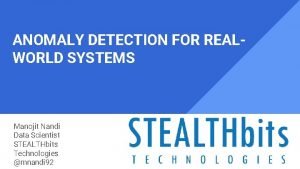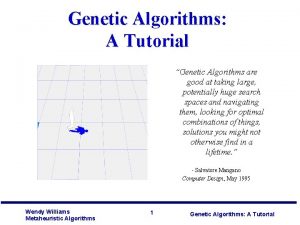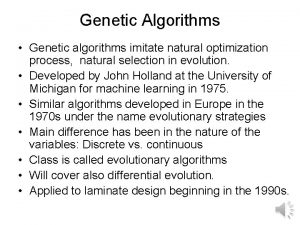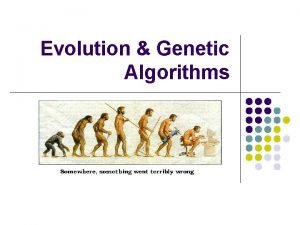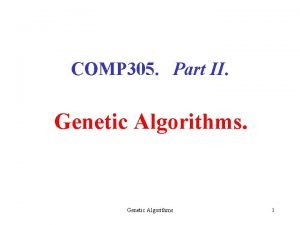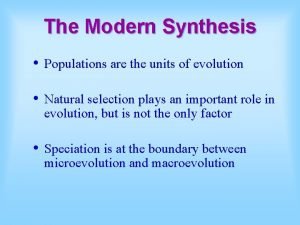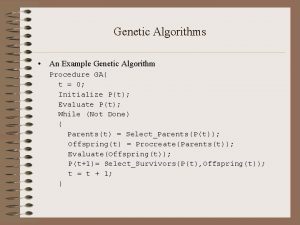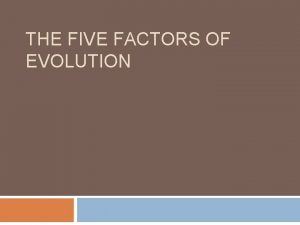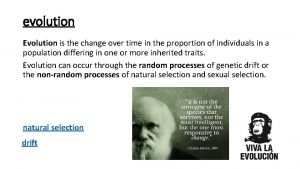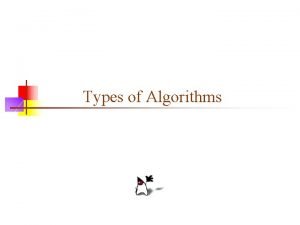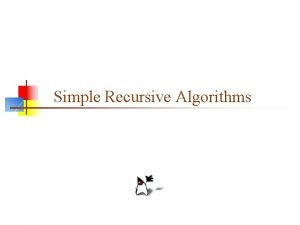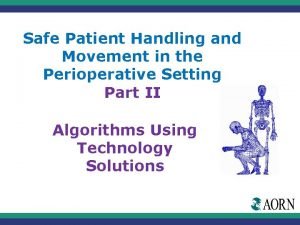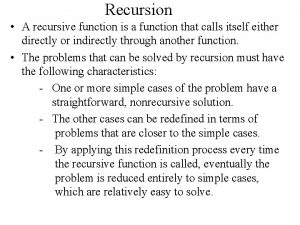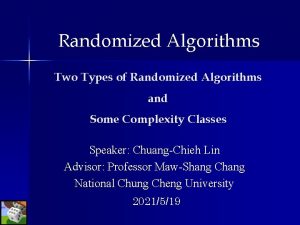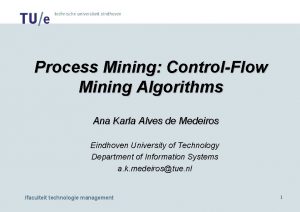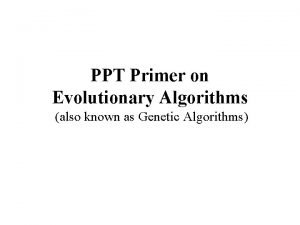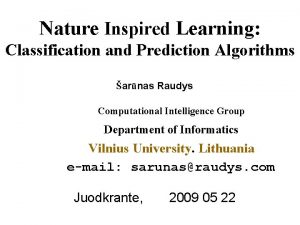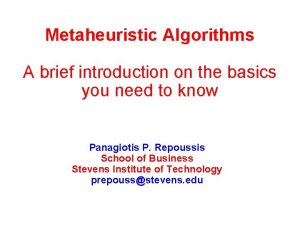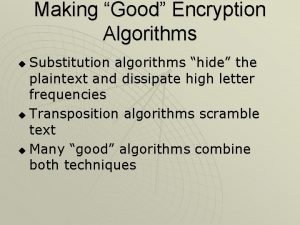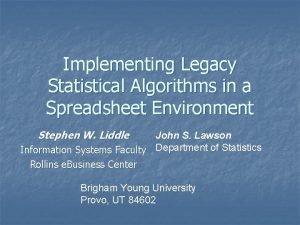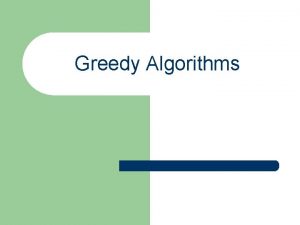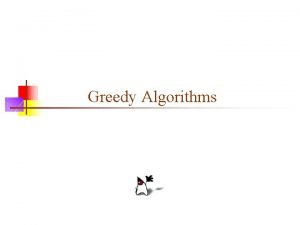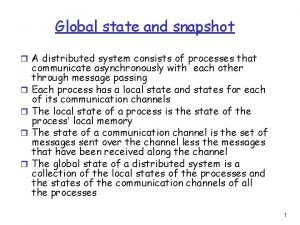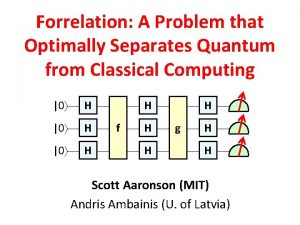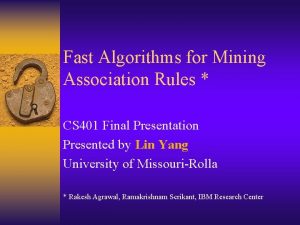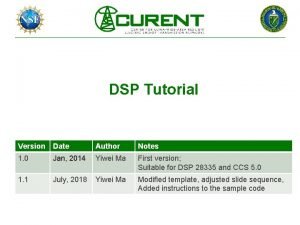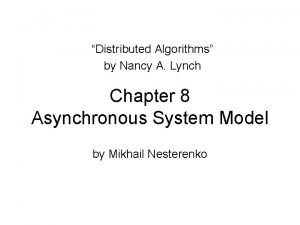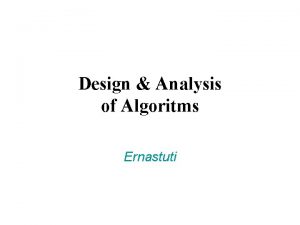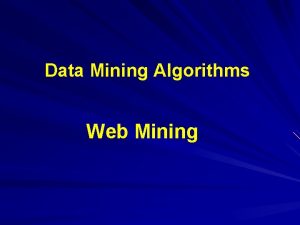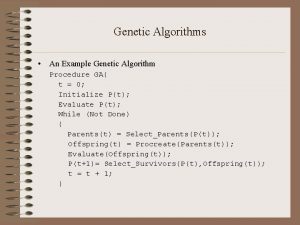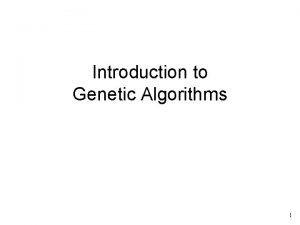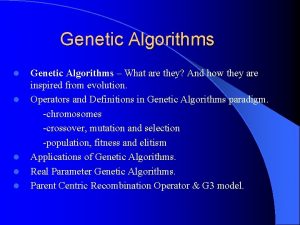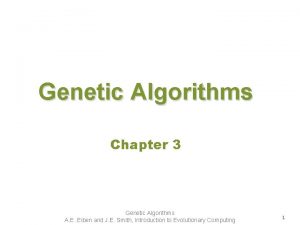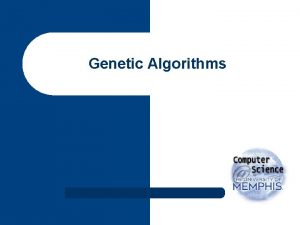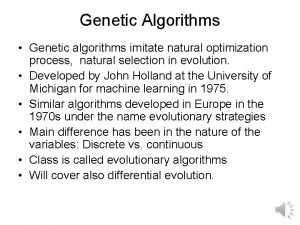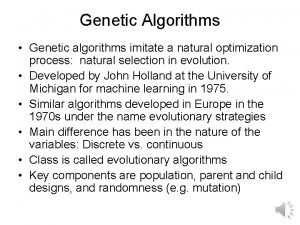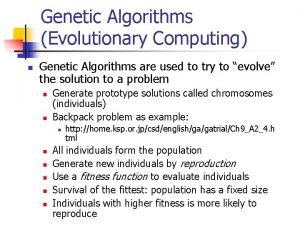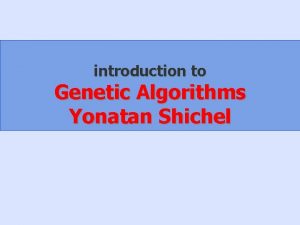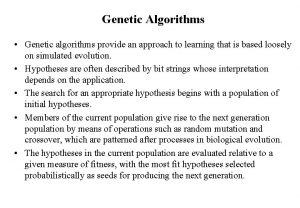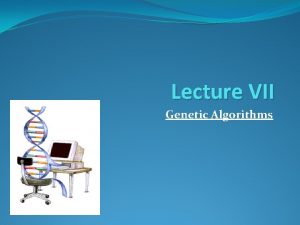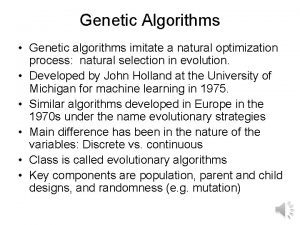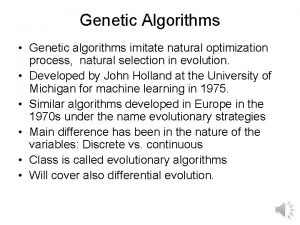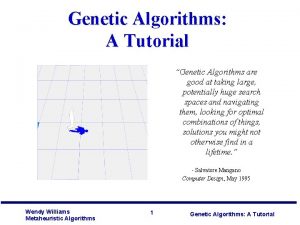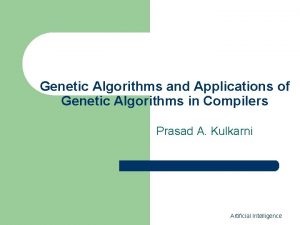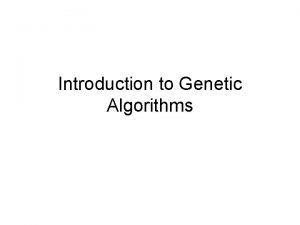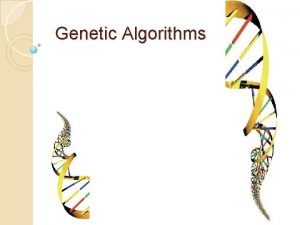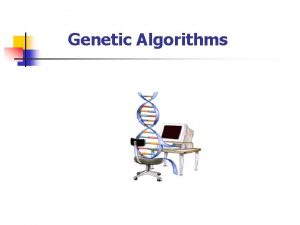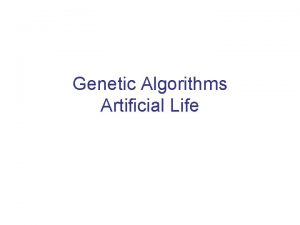Genetic Algorithms w An example realworld application Dynamic





















![Our Work w Training filters to specific target detection E = – [detection accuracy] Our Work w Training filters to specific target detection E = – [detection accuracy]](https://slidetodoc.com/presentation_image/66ec0477b5915670f93f57a44dd71e60/image-22.jpg)





















- Slides: 43

Genetic Algorithms w An example real-world application



Dynamic scenes



Test stimulus


Outdoors scene (easy)


Outdoor scene (harder)


TV ad


Other outdoors


TV news


Questions w This model uses hardcoded low-level visual feature detectors inspired from monkey and human brains w Are these the best possible detectors? w Why did our brains evolve in such a way?

Training Filters to Detect Specific Salient Objects Romain Bosa i. Lab April – July 04

Olshausen & Field, Nature, 1996 w Learning a sparse w E = – [preserve information] – k[sparseness] code for natural images w Basis function similar to receptive fields w Focus on picture reconstruction w Can be adapt to detect specific targets
![Our Work w Training filters to specific target detection E detection accuracy Our Work w Training filters to specific target detection E = – [detection accuracy]](https://slidetodoc.com/presentation_image/66ec0477b5915670f93f57a44dd71e60/image-22.jpg)
Our Work w Training filters to specific target detection E = – [detection accuracy] – k[sparseness] w Goals : n n n Automate specific target detection in natural pictures Try to understand better the learning process of object detection in human beings Use information on filters evolution during the training to be able to train analysts more efficiently

Detecting Fruits w First we tried to train filters in order to detect fruits (oranges and apples) in natural scenes w Training of 3 RGB filters 8*8 (9 grayscale filters, 9*8*8=576 coefficients) w Or, training on 3 greyscale filters 8*8 (3*8*8=192 coefficients)

The Data w Various pictures taken in i. Lab, and outside HNB w The objects to detect in these pictures are fruits: oranges, red and green apples w 14 pictures containing only one fruit are used for the training process

The Score Function w Object detection accuracy : n n Manually-drawn binary mask (ideal saliency map) (Max. Sal. Out – Max. Sal. In) / 255 + 1 w Sparseness : n Dot products of the filters (absolute values)

The Training Process w A wavelet transformation (Haar) is applied to the filters to train more meaningful filters : w Real function of 576 (or 192 for greyscale version) coefficients to minimize : the mean of the scores on each picture w The method used is a genetic algorithm w Filters are initialized with random values

Genetic Algorithm w Reduce number of possible filters by allowing each wavelet coefficient to only be -1, 0 or 1 w Chromosomes: sequences of 576 (color) or 192 (greyscale) numbers, e. g. : -1, 0, 0, 1, 1, -1, 1, 0, … , 0, 1 w Mutations: randomly change some value in the chromosome into another value w Crossovers: create two children by exchanging some of the genes from two parents

A “Population” Chromosomes: sequences of 576 or 192 numbers, e. g. : -1, 0, 0, 1, -1, 1, 0, … , 0, 1 Population: start with 200 “individuals” initialized with random chromosomes

Ranking by Fitness: For each individual: compute saliency map using the filters from that individual’s chromosomes, and measure how salient the fruits of interest are. Repeat over all training images and compute average score. This is the “fitness” of that individual.

Mate Selection: Fittest are copied and replace less-fit

Mate Selection Roulette: Increasing the likelihood but not guaranteeing the fittest reproduction Create N children from N parents (population size remains constant) 16% 0% 25% 7% 3% 11% 38%

Crossover: Exchanging information through some part of information (representation) 1, -1, 0, 1, …. 1, 1, -1 1, 1, 1, 0, …. 1, 0, 1

Mutation: Random change of binary digits from 0 to 1 and vice versa (to avoid local minima) In our case, Random change to -1, 0 or 1

Best Design

The GA Cycle

Computation on HPCC cluster w 193 nodes (CPUs) w 1 “master” node which keeps filters and score function up to date w 192 “slaves” nodes which handle score evaluation w MPI protocol is used for communications between nodes


Detecting Interesting Targets w Instead of trying to detect specific targets, we are now trying to detect targets of interest in satellite pictures w Training of 3 grayscale filters 8*8 w Same training process used w New score function

The Data w Satellite pictures with records of 4 subjects’ eye-movements (Rob’s data) w 10 pictures are used for the training process w The aim is to get a saliency map matching the eye-movement (in particular the end of eye saccade locations)

The Score Function w Detection accuracy : n n n Samples around end of saccades locations Si = max saliency in sample #i S = mean(Si) A = average saliency on the map Accuracy score = (A + 1) / (S + 1) w The sparseness score doesn’t change


Convolution by

Conclusion w The work is still in progress, but the training process seems to work better with the eye movement score than with the fruits detection. w The next step will be to train more filters, in order to get more accurate results. w This work can be really interesting in terms of satellite images analysis, because if we managed to train accurate filters, we would have an automatic and very efficient way to find interesting locations, as a human being would.
 Realworld systems
Realworld systems Genetic algorithms tutorial
Genetic algorithms tutorial Genetic algorithms
Genetic algorithms Lamarckian evolution
Lamarckian evolution Genetic algorithms
Genetic algorithms What is specation
What is specation Genetic programming vs genetic algorithm
Genetic programming vs genetic algorithm Genetic programming vs genetic algorithm
Genetic programming vs genetic algorithm Genetic drift vs gene flow
Genetic drift vs gene flow Genetic drift vs genetic flow
Genetic drift vs genetic flow Dynamic dynamic - bloom
Dynamic dynamic - bloom Genetic drift example
Genetic drift example Schema theorem in genetic algorithm example
Schema theorem in genetic algorithm example The five factors of evolution
The five factors of evolution Fitness in biology
Fitness in biology Computational thinking algorithms and programming
Computational thinking algorithms and programming Types of algorithm
Types of algorithm Simple recursive algorithms
Simple recursive algorithms Design and analysis of algorithms syllabus
Design and analysis of algorithms syllabus Safe patient handling algorithms
Safe patient handling algorithms Recursive method
Recursive method Types of randomized algorithms
Types of randomized algorithms Process mining algorithms
Process mining algorithms Evolutionary algorithms ppt
Evolutionary algorithms ppt Nature-inspired learning algorithms
Nature-inspired learning algorithms Tabu search tsp
Tabu search tsp Making good encryption algorithms
Making good encryption algorithms Algorithm analysis examples
Algorithm analysis examples Statistical algorithms
Statistical algorithms Ajit diwan iit bombay
Ajit diwan iit bombay Greedy algorithm
Greedy algorithm N/a greedy
N/a greedy Snapshot algorithms for fifo channels
Snapshot algorithms for fifo channels Classical algorithms for forrelation
Classical algorithms for forrelation Aprioti
Aprioti Dsp algorithms tutorial
Dsp algorithms tutorial Distributed algorithms nancy lynch
Distributed algorithms nancy lynch Analyze algorithm
Analyze algorithm Association analysis: basic concepts and algorithms
Association analysis: basic concepts and algorithms Virtual webview in data mining
Virtual webview in data mining Computer arithmetic: algorithms and hardware designs
Computer arithmetic: algorithms and hardware designs Cos 423
Cos 423 Computer networks routing algorithms
Computer networks routing algorithms Data structures and algorithms tutorial
Data structures and algorithms tutorial
